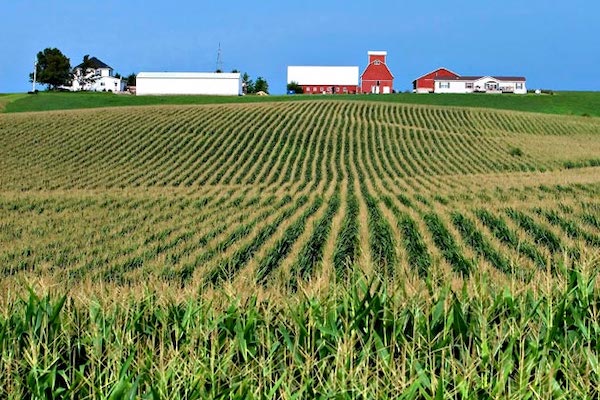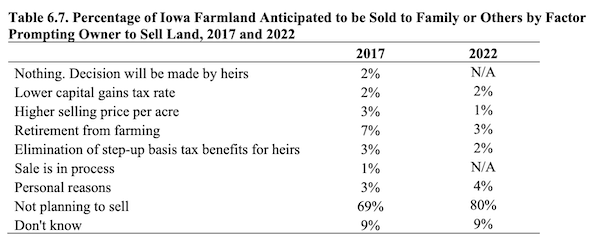Every five years, Iowa State University conducts the “Iowa Farmland Ownership and Tenure Survey,” which provides a current snapshot of the forms of ownership, tenancy, and transfer of the state’s farmland. This series of studies concerning land ownership is unique to Iowa, having been collected by Iowa State researchers since 1949 and mandated by the state to be conducted every five years since 1989. The newest survey shows the average age of farmland owners has continued to increase, as has the amount of farmland being leased.
A full 58% of Iowa’s farmland is now leased, and 82% of that was cash rented. “There is a long-term trend toward farmland leasing since 1982,” said Wendong Zhang, assistant professor of economics at Cornell University who conducted the survey with Jingyi Tong, a PhD student in the Department of Economics at Iowa State. The amount of farmland being leased is up from 53% in 2017, which Zhang says represents a relative increase of roughly one million acres.
The increase in cash rent correlates with the growing number of landowners who are part-time and non-residents of Iowa. In fact, 55% of land is owned by an owner who did not farm in 2022. Of those, Zhang says over half have no farming experience. According to the study, 47% of farmland was directly operated by the landowner in 2017, but that number has now fallen to just 42%.
An underlying trend that is likely contributing to these shifts is the rising age of Iowa’s farmland owners, with 66% now over the age of 65, versus 29% in 1982. A record 37% of Iowa farmland owners are 75 or older. Tong says several factor are behind the aging farmer population, including the increase in using farmland as an inheritance or long-term investment, fewer young people going into farming, and those young farmers facing large start-up costs. Tong notes that some senior farmers may retain ownership of their land due to a lack of succession planning, thus keeping the farm even if they aren’t actively farming.
The report notes that all these trends have significant implications for when and how farmland is intended to be transferred to the next generation. Willing or giving the land to family remained the most popular method of intended land transfer, accounting for 47% of all acres of Iowa farmland. The second-most popular intended method of land transfer was putting it into a trust or in a business entity, covering 26% or 12% of land, respectively. Only 4% of Iowa farmland was intended to be sold to a non-family member. When asked about what factors will prompt a landowner to sell some of their farmland, 80% of the land is owned by someone not planning to sell. In other words, we will continue to see a tight farmland supply. The full report is available at HERE. This is great work by the folks at Iowa State University!
Other trends revealed in the report include:
- 84% of Iowa farmland is owned free of debt, which represents a significant increase from 62% in 1982 and a further hike from 82% in 2017. Landowners 65 years old or above have at least 90% of land they own fully paid for. The debt-free percentage for landowners younger than 35 is just 17%, rising to 70% for those aged 35 to 64 years old.
- 46% of farmland is owned by women, and 13% is owned by female landowners over 80.
- The share of Iowa farmland rented out via fixed or flexible cash rental contracts is at a record high level of 51%, of which fixed cash rent was the most popular lease covering 42% of Iowa farmland.
- 37% of Iowa farmland is primarily owned for family or sentimental reasons, which represents a significant increase from 29% in 2017.
- There is a continuous shift away from sole ownership and joint tenancy to trusts, corporations, and LLCs, which accounted for 23%, 6%, and 9% of the land, respectively, in July 2022. In 1982, 80% of Iowa’s farmland was owned through a combination of sole ownership and joint tenancy, while the amount held in trusts was just 1%.
- 55% of Iowa farmland is owned by someone who does not currently farm and 53% of those owners have no farming experience.
- 20% of Iowa farmland is owned by someone who is not an Iowa resident, which increased from 13% in 2017. Of the non-resident landowners, 70% of them do not have farming experience
- Cover crops are grown on 7% of Iowa farmland, which represents a significant jump from 4% of farmland in 2017. The use of no-till rose to 30% of acres in 2022 from 27% in 2017.
- 20% of Iowa landowners have already participated in a carbon credits program and another3% are considering carbon opportunities.
- Three of every four landowners in Iowa are interested in selling land to beginning farmers when incentivized with federal and state tax credits. About 75% of landowners are willing to sell land to hardworking beginning farmers at fair market value, but the ratio drops to 40% for below fair market value.
- Over half of Iowa landowners expressed concerns about difficulty finding quality beginning farmers as well as concerns about beginning farmers’ ability to pay top prices.













